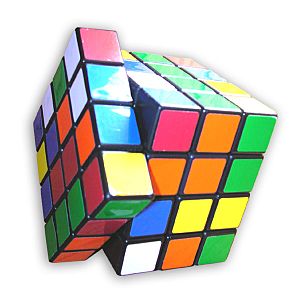Group (mathematics) facts for kids
- This article is about the basic ideas of groups. For more advanced topics, see Group theory.

In mathematics, a group is a special kind of setup. It helps us understand how things can be combined or changed. A group has two main parts: a collection of things (called a set) and a way to combine any two of these things (called an operation). When you combine two things from the group, you always get another thing that is also part of the group.
Instead of saying "an element of the group's set," mathematicians usually just say "an element of the group."
Mathematicians often use big letters like G, H, or K to stand for groups. They use small letters like a or b for the things inside the group (the elements). So, "a is in G" means "a is an element of the group G."
They write group operations with symbols like • or *, or by simply writing two elements next to each other. For example, "a • b", "a * b", and "ab" can all mean "the element you get when the group's operation combines a and b."
Not every collection of things and an operation will make a group. A group's set and operation must follow some special rules. These rules are called group axioms.
Contents
The Special Rules for Groups
- Closure: When you combine any two elements from a group using its operation, the result must also be an element of that same group.
- For all a and b in group G, a • b must also be in G.
- Identity Element: Every group has one special element called the identity element. If you combine the identity element with any other element, the other element doesn't change. The identity element is often written as e. Sometimes it's written as 0 or 1.
- There is an element e in G such that for any a in G, e • a = a • e = a.
- Associativity: If you combine three elements, it doesn't matter how you group them. The final answer will always be the same.
- For all a, b, and c in G, (a • b) • c = a • (b • c).
- Inverse Element: Every element in a group has a partner element called its inverse. When you combine an element with its inverse, you always get the identity element. The inverse of a might be written as -a or a-1.
- For each a in G, there must be an element b in G such that a • b = b • a = e (where e is the identity element).
More Cool Ideas About Groups
To fully describe a group, you should mention all three parts: (the set G, the operation •, and the identity element e). But often, if it's clear, people just say that G is a group.
Sometimes, if you combine a with b (a • b), you get a different result than if you combine b with a (b • a). For example, a • b might be c, but b • a might be d.
However, for some groups, a • b is always the same as b • a for every a and b in the group. These special groups are called Abelian groups. Their operation is said to be commutative.
The number of elements in a group is called its order. A group can have a finite (countable) number of elements or an infinite number.
Examples of Groups You Might Know
Integers, Addition, and Zero
A common example of a group is the set of integers (whole numbers like -3, -2, -1, 0, 1, 2, 3...). The operation is addition, and the identity element is zero.
- Closure: If you add two integers, the result is always another integer. So, this rule holds true.
- Identity: Adding zero to any integer doesn't change it (e.g., 5 + 0 = 5). So, zero is the identity.
- Associativity: When adding three integers, the order you group them doesn't matter (e.g., (2 + 3) + 4 is the same as 2 + (3 + 4)).
- Inverse: Every integer has an inverse. For example, the inverse of 5 is -5, because 5 + (-5) = 0 (the identity).
This group is also an Abelian group because the order of addition doesn't matter (e.g., 2 + 3 is the same as 3 + 2). It's an infinite group because there are endless integers.
The set of integers with multiplication is not a group. This is because most integers don't have an integer inverse for multiplication (e.g., the inverse of 2 for multiplication is 1/2, which is not an integer).
Symmetries of Shapes
Another important type of group is a group of symmetries. Think about how you can move or flip an object so it looks exactly the same.
- Each way you can move or flip an object (a symmetry) is an element of the group.
- The operation is doing one symmetry and then doing another. The result of combining two symmetries is also a symmetry, which means the closure rule works.
- The identity element is the symmetry where you don't change anything at all.
- Every symmetric change can be undone by reversing it. That reverse is the inverse element.
Symmetry groups are found everywhere. For example, consider a square. Its symmetries include:
- Turning it clockwise 90°, 180°, or 270°.
- Turning it counter-clockwise 90°, 180°, or 270°.
- Reflecting it across a vertical, horizontal, or diagonal line.
- Leaving it unchanged (the identity).
This is a finite group because there's a limited number of ways to move the square. It's also a non-Abelian group. This means the order of operations matters. For example, if you turn a square 90° and then reflect it, you might get a different result than if you reflect it first and then turn it.
It can be shown that every group with a finite number of elements is like a group of symmetries. This is why group theory is often called the mathematical study of symmetry.
Other Kinds of Groups
Many things in mathematics can be seen as groups. For example, the ways you can solve certain equations can form a group. Even physical things have symmetries that can be described using groups.
Sometimes, a part of a group is also a group itself. When this happens, that part is called a subgroup. For instance, if you only consider the turns of a square (and the identity, but not the reflections), that forms a subgroup of the full square symmetry group. Many useful things can be learned by studying groups and their subgroups.
Images for kids
-
This image shows a special kind of pattern called a tiling. The way this pattern repeats and fits together can be described by a group of symmetries.
See also
 In Spanish: Grupo (matemática) para niños
In Spanish: Grupo (matemática) para niños


